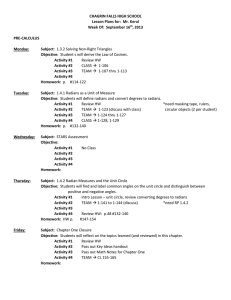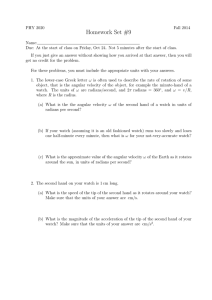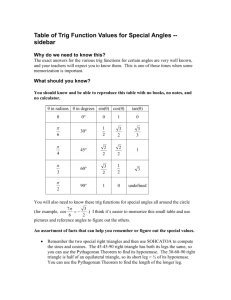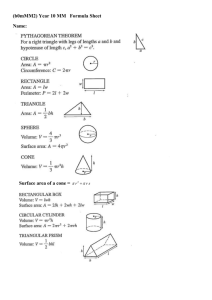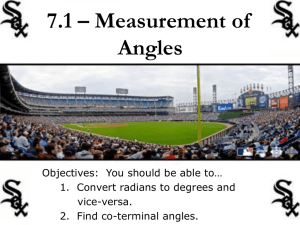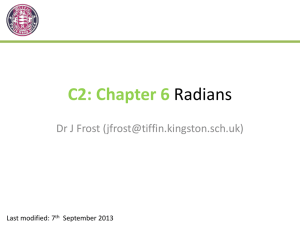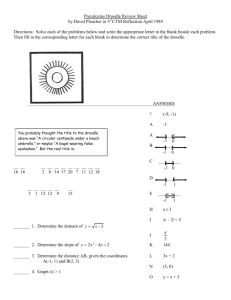Simulated Pion Photoproduction Experiments Ethan Howe
advertisement
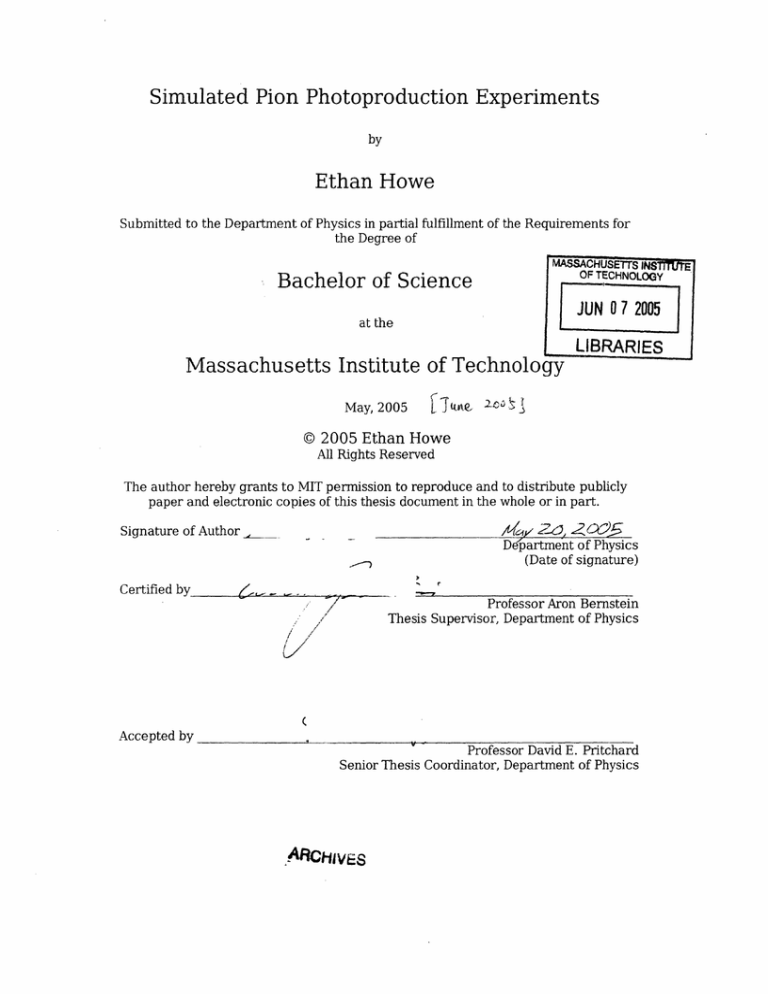
Simulated Pion Photoproduction Experiments
by
Ethan Howe
Submitted to the Department of Physics in partial fulfillment of the Requirements for
the Degree of
MASCHUSEtrrS
INSTE
Bachelor of Science
OFTECHNOLOGY
JUN 0 7 2005
at the
LIBRARIES
Massachusetts Institute of Technology
May, 2005
LJ
2aed g-oA
© 2005 Ethan Howe
All Rights Reserved
The author hereby grants to MIT permission to reproduce and to distribute publicly
paper and electronic copies of this thesis document in the whole or in part.
Sicnature of Author
/t¥/V 2-(,
-_)
C,
Department of Physics
(Date of signature)
.
_
_
,
_
rt
Certified by
Professor Aron Bernstein
Thesis Supervisor, Department of Physics
../
/
I
Lx
(
Accepted by
Professor David E. Pritchard
Senior Thesis Coordinator, Department of Physics
,AFCHIVES
Simulated Pion Photoproduction Experiments
Ethan Howe
MIT Department of Physics
(Dated: May 20. 2005)
I present the details of my simulation for the proposed polarized target. polarized photon. pion
photoproduction experiment at the new HI-yS facility. This experiment will make important mneasurenients of the multipoles for pion production in the near thershold region which will sed light on
chiral symetry breaking. I detail the parameters of the NNIS detector to be used for the experiment
including its acceptance and resolution. I reproduce the cross section that we are hoping to measure.
I present the results of fitting the cross section coefficients by two different methods and compare
their accuracy. I conclude by discussing further improvements that will be made to my simulation
by fture students investigating this experiment.
Contents
1. ][ntroduction
1
L[.1.Polarized Cross Section
9
2. Simulation Details
'.1. The NMS Detector
4
6
3. Fit Results
11
4. Conclusions and Future Work
16
References
18
5. Acknowledgements
18
A. Simulation Script Names and Functions
25
1.
INTRODUCTION
In this paper, I will be assessing the capabilities of the Neutral Meson Spectrometer (NMIS) detector in a planned
experimenet at the High Intensity Gamnma Source (HIl-S) at Duke University. I will review the relevant theory and
set out the iportance
simulation.
of this experiment. I will describe the proposed apparatus and how I have modeled it in my
will explain the data we wish to draw from the experiment and present results as to how well I believe
this setup will perform.
This experiment will be the first to measure many of the double-polarization observables for pion photoproduction
in the near threshold region. The production of pions depends on the strong force, which is described by quantum
chrono(lvynaini(cs (QCD). For light nesons, an effective field theory called Chiral Perterbation
Theory (ChPT) has
been developed, which calculates a perturbative approximation to QCD. The mass of the quarks results in the breaking
of chiral symmetry. The neutral pion (7r0) is the lightest meson and thus is closest to the chiral limit. The production
of w0 will shed light on spontaneous chiral symmetry breaking in QCD, a fundamental part of the structure of matter.
Isospin is particularly interesting in chiral dynamics.
Isospin is a fundamentally conserved quantity that explains
mnanydisallowed processes in particle physics. The violation of isospin due to the differences iln up and down quark
masses in the pion photoproduction system was predicted twenty years ago by Weinberg. [2] The measurement of the
polarized cross section will allow determination of the amount of isospin breaking i the
N system. There are several
competing theoretical mnodelsthat predict the observables for this system in the near threshold region. In addition to
Ch"PT one loop, there are MAID [6] and DMIT [7] model calculations. These theoretical and model calculations will
be stringently tested bv the filture HITySdata.
1.1.
Polarized Cross Section
The differelntial cross section for pion photoproduction has the form shown in figure 1 where each R is anlobservable
of the reaction, the h in front of the last term is the helicity of the photon beam, p* and k are the center of mass
momenta of the pion and photon, respectively.[4] [5]
dj/dQ* = p /k2{RT + P0 R' + fIT[(RTT + PnRTT) cos 2
-(PRTT + PtRtT)sin
liH and Ic
2] + eHc(PIRITT, + PtRtT,)}
(1)
are the amounts of photon linear and circular polarization, respectively o a scale fom zero to one. The
P terms are determined by the amount and direction of target polarization being used. We have chosen to define
these terms relative to the lab frame so that we get the following values: If the target is polarized normal to the
plane of the floor P, = PT cos( b).
7
Pt = PT sin(¢,),
and P = 0 where P
is the amount of target polarization
again oni a zero to one scale. If the target is polarized perpendicular to the beam, in the plane of the floor, then
P, ==-PT sin(,),
Pt =
PT
cos(,),
and P = 0. If the target is polarized along the beam then P = Pt = 0, and
P = PT. (¢=,is the pion azimuthal angle in the lab frame and
is the angle between the photon polarization and
the plane of the photoproduction reaction. For photons polarized in the plane of the floor
polarized perpendicular to the floor (I = 27r polarization observables.
RT
=
=7and fr photons
,. RT is the unpolarized observable and RTrT and R+ are the single
has been measured in many experiments in the threshold region but
been mneasured only once so far for 7o. [1] It is important to note that this measurement of
RTT
RTT
has only
disagreed with the
predictions of DMIT. In the H7S experiment, we would like to verify or dismiss this discrepancy. The five double
polarization observables will also be accessible although R'T
R'T, and RtT are all relatively small and will be hard
to measure accurately. These observables canllbe defined in terms of the complex S and P wave multipoles of the
interaction E,)+, El+, A11+. and
111-.
is the center of miass pion polar angle:
Examples of these expansions are shown in the following equations where 0
:3
R>T
liT
~~±
IEO+I2
+
= ~
2
~ (12AI1+ + ~ I2-+3E1+
-I
r
+13|E~-
2)
- Ali+
g/+ ±
+ Mh-2)
2~~~~~~~~~~~~~~~~~~~~~~~2
(2)
(2
+2cos(O)4 {EO+ (3E 1 + - I 1+ + Ali-)}
+ cos 2 (0)(13E+
( 2AI
R
-
Ml+ + A11
+ ll
+ 13E
+
-Mll+ llll_12)
2 )
(3)
= 3siln(O) {E()+(El+- Ai+)
ix+2-/,_ )}
A1)+
-
-cos(0)(E+ (4_ z+
1
RT
2
3sin 2(0)
E
+ -
12 _1
{FE+(II+ - A1-)+ A
R+T = sin(O)>s{Eo+(3Ei+ + M1 + + 2M_1 )+ 3cos(O)ll
1 _(3E+
AI1}
+ l/M+I)}
(4)
(5)
The terms of these expansions can be rouped together into coefficients that multiply each function of 0. These
coefficients are shown in equations 6-9 and their definitions can be deduced by comparison to the previous definitions.
RT
= aT + bTcos(0) + CTcos 2(0)
(6)
R
=
:sin(0)(a' + b+ cos(0))
(7)
RTT = aTT Sil (0)
RT
= sinl(0)(a
T
(8)
+ bTT COS(0))}
(9)
These multipoles and coefficients are the values that I will be fitting in the results section of the paper. Further, if
we split up the terms of equatio
1 according to the two polarizations, we can see which parts of the ross section
we can isolate by flipping the polarizations. From this perspective there are three pieces: observables unchanged by
polarization reversal, observables that change sign by target polarization reversal, and observables that change sign
by both target and photon polarization reversal. These three groupings are shown in equation 10 where h is again
the
lphotonl
helicity and we have separated the target sign into the
htT
elicity term.
hT = sign(PT) = ±1
h.
(10)
±i
(doT/dQ*
),,,,h, = p±/k
+HRTr
TRTTcos2 i + hT(PrR
+ T[PTRT
cos 2b
- (plRT + PtRTT)sin24]) + hThII (PRTT, + PtRTT,)}
4
XVecan
iuse these
dearees of freedom in the apparatus to eliminate different pieces of the cross section by subtracting
data with different helicities. Equations 11-14 gives the four possible separations.
(du/dQ5*)i.i- (d/dQ*)l,_
(du/dQ5*)l.i+ (da/dQ*),_
=pp;/k*;{RT +TRTTcOS24
= p/k(nc
(dutc/dQg*)1.i
+ (dj/d*)i,_q-
+ PtRTT'))
(11)
(12)
+ (PR¢ +HT[PflRTcos2±
(Pi RTT + Pt RTT) sin 2 ])
-
(daj/dQ*). + (d/dQ)l_,
(PIRT/
+ (da/d2*i)_. + (du/dQ*')_l_i = p*/k(RT + HTRTTcos 2)
(do/d*)_j. 1 - (do/dQ*)_t_w = p*/k*(PRr
(13)
+HT[PnRnT cos2I
(14)
- (PIRTT+ PtRtT)sin2] )
Here, we see that we have a number of degrees of freedom in the way we use the polarizations for the apparatus.
NVe
canl keep the same polarizations over a whole run and examine the overall cross section. Alternatively, we canllsplit the
runl time up into portions witlh different polarizations and then subtract the cross sections fomi each run and fit each
of the above pieces separately. Now that I have described the motivation, goals. and theory behind this experiment,
I will detail the apparatus proposed to make these measurements.
2.
SIMULATION DETAILS
Before the actual experiment begins, we need some understanding of what we canl expect from our apparatus. To
get a
idea of these expectations, I have created a simulation of data generation, detection, and analysis
numnericalpackage called ROOT.
Using
the
Ve pseudo-randomly generate certain unconstrained variables such as the phi angle
of photon decay and other variables are also random but they fall within a certain probability distribution such as the
cross section. Some details of the detector have been abstracted away into Gaussian or piecewise defined distributions.
For instance. the errors produced from reconstructing photodetection across the crystals making uipthe detector have
been simulated separately in GEANT and then imported as a table into my simulation. [8]
I split the simulation up into distinct parts. First, there are two pieces to every run, generation and analysis. I have
separated these programls into two distinct scripts so that i theory when the experiment is performed the analysis
script canI be run on that data as easily as it can be run on the simulated data. These scripts can be found on the
LNS network under the directory /export/lnan/dataO3/ethanhow/root.
For more information on the nanme and ulse
of each script, refer to appendix A. There are also two types of runs that are performed, acceptance ad
data. Tlhe
acceptance run contain a much larger number of events to reduce statistical errors. The acceptance of the detector is
found by knowing the input and output angles and dividing out the number of events that are detected in each angle
bin. This process nakes the acceptance independent of cross section and only dependent on the detector geometry.
The dalta analysis uses the acceptance to reconstruct what the cross section should have been based onIthe percentage
of counts 'we should have seen i each biln.
The simulation begins b calculating kinematic parameters of the interactions between the photon, proton, and
pion. The photon energy is input as a constant and that energy and momentum is split between the recoil of the
l)proton,te mass of the pion, and the kinetic energy of the pion. The protoni is assumed to be stationary but a
future addition would be to add zero-mean thermal distribution to its momellntuml. These kinematics remlain the
same for all photoproduction events. The differences begin with the pion production polar and azimuthal angles, *
and q)*, respectively. T'he stars superscripts denote that the angles are in the center of mass reference frame for the
photoproductionl reaction (referred to as the CM frame from now on). The pion angles depend on the cross section
that was introducedin section 1.1. The differential cross section is in units of solid angle. I take this fact into account
by milltiplying the cross section by sinl(0) and using bins of 0* and O' in nmyanalysis. Following its creation the
pion will decay quickly into two photons. Since there are no outside interactions involved in this decay, the photons
are produced back to back in the pion stationary friame. Thus one theta and phi define the photon decay process.
These angles are uniformly random because there is no preferred directionl of decay. Finally I translate these angles
that have been produced in different frames back to the laboratory where they are actually detected. The photon
energies and momlenta are Lorentz transformed from the pion frame to the CM frame using the energy-momentum
four vector of te
pion. The Lorentz transform is shown in equation 16 where
and ^/ define the magnitude of the
transformI. p (p') is the original (transformed) momentum, E (E') is the original (transformed) energy, and
x.
y,
are the components of the vectors.
p = pi + bi(
'
j +
+E)
(15)
:'+ 1
E'= ,(E +j- pf
Then the CMNI
frame is transformed to the lab frame by the photon energy. After these operations are complete, I
have all the data that will be detected in the experiment, the angles and energies of both photons in the lab frame.
In add(ition, I place the correct 0. and O* in the data file so that I canl check my calculations, and assess the accuracy
of the detector. To determine the number of events created b the target, I use equation 17 where Nt is the areal
density of the target, n'tot is the total cross section, N4 is Avogadro's number, Ptarqet is the density of the target, t is
the rm timne, and I is the beamr intensity.
'Vt =
o7tot
NA * e'ngtht(,.get * Ptarget
(16)
4(aT + CT/3)
Nevents = t * I * Nt * (7tot
I used(the following values for each of these variables based onlour expectations of the final apparatus: Ptarget= 0.0708
for a liquid H 2 target, I = 6 x 106 photons/second.
For a run time of 100 hours. these numbers yield 1.43 million
events. Next, we woul(l like to know how manyvof these are actually detected by our detector.
6
2.1.
The NMS Detector
The Neutral MNleson
Spectrometer (NMS) is the current proposed detector for this experiment. The NMISwas built
at Los Alamos Meson PhyvsicsFacility and it contains a number of systems that we will not be using at HI-YS. Vewill
be stripping off vetoes;, BGO crystals, and wire chambers that were present to improve the efficiency of the device.
These devices were previously used to screen out charged particles and to improve the energy resolution. Our purposes
require good position esolution to investigate asymmetries and the highest statistics we can achieve since the total
cross section is small. For our setup, an array of cesium iodide crystals will remain. The detector is split into two
arms placed on either side of the photon beam (see figures
and 2). Each arm of the detector is a 4 x 8 (x versus y)
block of CsI crystals fom total dimensions of 36 x 81 centimeters.
'1
[1
]
n
r2
ir 2
FIG. 1: 'he figure shlows the proposed experimental apparatus. There are three coordinate systems, oe for each detector and
one fo te lab. Thle laboratory floor is the x-z planie i all three coordinates.
7
9.093
I cm
10.16cm
Y C'
BY
X
7-
FIG. 2: Te figure shows the face of the detector. There are 8 C'sI crystals in the y direction and 4 crystals in the x directions.
The crystals have slightly different dimensions in each direction. I assume that the face is completely fat in the current
simulation.
The analysis script takes the raw dlata from the file and translates it to detected events. The script reads each
event and calculates te position where the event strikes the detector from equation
18.
Rd is
the distance from the
place the pion is produced to detector, 0d is the angle between each detector arm and the beam, and 0b and &7 are
the angles of the photon. Rememiber that 07 and 0 fr each photon are what I record in the data file so that I could
substitute a different detector by just changing equation 18 in the analysis code. The plus sign denotes the photon
hitting detector
and the minus sign for detector 2. The difference corresponds to simply changing the sign of 0f.
The hit patterns on the detector faces calculated by these equations and generated by the polarized cross section are
shown in figure 3.
' =
-Rdi(+ sin((Od) cos(
) - cos(0d) sin(07) cos(¢))
cos(0d) cos(0 7 ) ± sinl(0d) sin(0 7 ) cos(q, )
(17)
Rd sin(0.) sin(o,)
± sin(Od) sin(O^) cos((p) + cos(0d) cos(0)
If we had a perfect detector and a point target, then the data registered by the detector would be exactly determined
by these equations. In the next step of analysis we add what errors we actually believe to see in the experiment. My
simulation adds four types of error: x and y position, energy, and finite target. The x and y position error occurs
S
Detector 1 Hit Pattern
|
Detector2 Hit Pattern
I
40F
I
40
30
0
20
20
X10_
10
U
0
--
.
-20
-30
-40
-20
-
..:..".l
-40
..
.....
.:i-j.'..".:..'I ..I'I·":=_-40' ..·....--.-.:
-
-3
-40
_
-20
-15
-10
-5
0
5
Detector X axis
10
15
20
[IG. 3: Photon hit patterns for detector
-20
-15
_ __
_ _ _.. _
-10
_ _.
-5
0
5
Detector X axis
_ _:
10
15
20
and detector 2 onl the left anid right. respectively.
because of the difficulty in resolving the amount of energy deposited in the crystals surrounding the photon impact.
The CsI crystals are not well designed for this task since their Molibre radius is small compared to the dimensions
of the crystal. Thus wvhena photon is absorbed in the middle of a crystal a very small amount of its energy spills
into other crystals. The differences in energy distributed among crystals determines where the photon struck. Thus
if the energy is contained only within onie crystal then that photon must be assumed to be at the exact enter of that
crystal. Mohammed A.hmed has simulated these properties of the NMNIS
detector and determined the average amrnount
of error introduced dlepending on the location of the photon within each crystal.[8] Currentlv I am not taking into
account the fact that some photons will be placed directly in the center of a crystal but rather using the average errors
at each position to geilerate a Gaussian displacement from the true location of the hit. This error is different in x and
v since the crystals are longer in the
direction. You can see these errors in figure 4. The total energy detected for
each photon is also subject to error. This error is proportional to the energy of the photon (see figure 5). Though you
can see that the crve is concave so the error as a percentage of energy is decreasing because the photo-multipliers
are more sensitive at larger energies. To factor these errors into the exact data, I sanmpled randomly from a Gaussian
distribution with standard deviation equal values of the position and energy resolution functions. I then added the
amount each returned to each variable independently.
The last resolution comes from not knowing what position
within the target that the pion is produced. I accounted for this unknown by choosing a uniformly random position
alon,g the length of the target for the pion to be produced and then changiing the hit position of the photons with
equation 19. These errors give the simulation its likeness to the real world and we are interested in their contributions
to our analysis.
!)
DetectorX ResolutionDependenton PositionwithinCrystal
E
DetectorY ResolutionDependenton PositionwithinCrystal
-
52.2
if.4
IW
-
0 ch 2
01.8
4)
*0
51.6
1.4
1.2
0
1
2
3
4
5
6
Detector X Axis
7
8
9
0
2
4
6
Detector Y Axis
8
10
FIG. '1: 'Ihe plots show the mnigitude of Gaussian error added to the positions of detected photons based o teir
with a particutlar crystal. The left and right plots represent the x and axes, respectively.
zdisp = lengthtarget (rand()
R' = Rd -
0.5)
position
(18)
disp COS(0d)
% = Xd - Zd1Sp sin(Od)
I define the detector acceptance as the percentage of pion production events that are detected. To have anl event
detected, both of the photons from the pion decay must be registered. one in either side of the detector. WVehave
determined that the angle between the beam and each detector that detects the most events is approximately 81
degrees. To mneasure the acceptance of each bin in Or and O*, we create a data set that is a
order of magnitude
larger than our actual data set. The cross section of this data can be whatever the programmer wishes the only
difference beillg in the bin errors of the acceptance. These errors should not matter much since the acceptance run
has mIuch higher statistics answay. I ended up using a flat cross section so that I could get more counts in the low
percentage binlls.To find the acceptance. I run the analysis uLpto determining which photon pairs are detected. Then
I take the pion angles from the data set and divide the number of detected pions over the number created pions in
each angle bin. The acceptance is shown in figure 6. The acceptance depends on the energy of the photon beam and
the geomnetryof the detector but nothing else since we are taking a ratio of detected events. To avoid te large errors
associated with a small accep)tance, I cut off the events analyzed at the 0} bin where any percentage along te O* fell
below 30%/. Thus looking at the acceptance figure. only the green and red regions of the cletectedevents were used.
10
IDetector
EnergyResolution Dependent on the Actual Photon Energy
4.2
4
>3.8
(D
,3.6
o
w
Uj
c3.4
.U
m
ICn
=3.2
0
ao
3
0)
.'2.8
cm
22.6
2.4
f.4~
_
.
30
. , ,. I ,. , ,. I I. , ,. I. I ,. I ,. , i I I.... , . I I I I . . . .
40
50
60
70
80
Photon Energy (MeV)
90
100
FIG. 5: The plot shows the absolute magnitude of the Gaussian error added to the photoni energies
After we have gonle throughll these steps. we can begin to examine the properties of our detector. First. we would
like to mlake sure thal te
errors we have added are in fact on te
order of magnitu(le we expect over all counts.
Figure 7 shows the dlifferent types of error induced anrd their mnagnitudes for different cases averaged over a number
of events. Next. we cail examine how well we measure certain constants of the interaction. These include the si1m of
the photon energies and the missing mmass
defined bIyequation 19.
z- ,/2(c, x c,?- pi - jj'2)
(19)
Both of these distribution have significant widths because of the inaccuracy of the energy measurement (see figuire 8).
Finally. we (can calculate the pion CM angles from the positions of the detected events. This reconstruction uses
equation
20 where Pr]
is the niornentuml of photon 1 in the CM framne. To get these photon mnormentain the center
of mass, I take the components of the photon nmomentum in the lab and use Lorentz transfornm in equation 16 on
them with the known beani beta and gamnia.
/
((Pyrl+PyrX2) + (
! (('~,I+P_
2
!Y
!
+I
PY2
)2 + (P
!
Y
+
+;
)2)
o'_
0* = arccos((p',zt +pTz 2 )/E*)
: =7 artan(p?.- tI + Pyt2
PTY2 PP
P-x I +
x2)
(20)
(21)
(22)
The distributions of the error in the reconstruction are shown in figure 9. Since we are examningir the cross section of
11
jPercentage GeometricEfficiencyof the NMS Detectorat 158 MeV
IPercentage GeometricEfficiencyof the NMS Detectorat 158 MeV
3I
......0.....
0.09
.
.
~~~~~~~~~~~2.5
.
0.082
K
0.07-
Z
2
0.060.05-
Qv
(U
0.04-
c.5
0.03-
(9
0.02
0.01-
1
03
0.5
n I
v,
-,.
-'>
O
I
91
-~
- I
An'
v/
iii
10
i
a~
,
n (Rad)
FIG. 63:Or te left. te acceptance of the NMS detector for 158 MNeVpion productio sowni as a 2-D istogrami. The colors
indlicate the 0-30. 30%--70{/. arid 70-1007c regionrs of the histogram. On the right. a conitour rrmap of the acceptance with 12
equidistant
oritoulr levels.
the pion CM angles, these errors are the main contribution to the error in our fits. There is one further important detail
aboult our simrulated experimental setup. I have assumed that I canllseparate the photons registered in te detector
producedl by 7 0 -proton events from all other background. This is a significant assumption (aside from standard noise
remnoval)because some proposed target contain carbon. which exhibits a cross section nearly 100 times larger than
tihe proto
in the near threshold region. This difficulty will have to be avoided by one of three mrethocls:1) Use a
pure liqurid hydrogen target.
2) Use an active scintillator target so that the amount of recoil from a count car be
registered. 3) Remove most of the detected counts from carbon b observed energetic
ifferences. I have assumed a
pure liquid hydrogen target for my simulations but any one of these strategies should prodluce the same results. With
this (lescrip)tion of te
aplparatus, I have fit te
cross section of pion production in various ways.
3.
FIT RESULTS
I used the Minuit utility to perform 2 fits on the reconstructed pion CMNangles. I started by fitting the coefficients
of the cross section as presented in section 1.1 sillngthe exact pion angles assuming a 47r solid angle coverage detector
and zero errors to assess the accuracy of the fitting mechanisnm. The results of this test fit are shown in table I. I have
only presente( te results for te examrples of tile coefficients given i that section i te table. The plots on te other
hiand include all 14 coefficients that I used. I have also presented figures comparing the input cross section and the fit
cross section with the detected counts and statistical errors superimposed. I have taken slides of the plots at different
12
I R...
i. h. .- di-fi..
fthi. 1.0 ..
f -fl b...dy
Resolution in the x-direction
I
_.
t
___-:
800-
_
- I
,
n
! "/ _
I '11I
I'll
.-.-
.-
_
. I
42s~,s2I
I-
~)
0~1
in the y-dirction within 1.0cm o cel boundry I
I
waw
..
I Resolution
within 1.0cm of cell centerI
I
i
Enirr
n
l_.
I-
700
-.1I
0.0 lg
I
700-
- .0,
600
600500
500-
400
400I l l
300
300-
200
200-
100
1O0-
^4,,,
U
.'
-10
1,,, I
I..
-8
I. ,
.
-6
.
...
-4
I
I. . . I. . . I. .
,,....
I,,,,,
-2
0
... I
l
4
Error added to hit x-coord
-10
8
6
10
(cm)
-8
-6
Error added to hit x-coord (cm)
-4
.......
I......
-8
-6
-2
0
2
4
Error added to hit y-coord
6
8
10
-20
-15
(cm)
_
z,,,,,,
-10
-4
-2
0
2
4
1
1 1 Illl1
,
, I* ....
2
6
8
10
Error added to hit y-coord (cm)
-10
-5
0
5
Error added to energy
10
15
(MeV)
FIG. '7: 1) IError added to x-positioni on the detector within 1 cmt of a crystal boundarv. 2) Error added to x-position o0 te
detector within 1 cm of a crystal center. 3) Error added to y-positiott on the detector within 1 cm of a crystal bountdary. 4)
Error added to x-positio o the detector within I cm of a crystal center. 5) Error added to te energy over all events.
values of * so that comparisons between the fits can be madle easily (see figure 10). One further test of the fits is
the distribution of bins on either side of the fit. Figure 11 shows that the input and fit have approximately the same
number of bins
(above
and below them. The calculation of the bins for these distributions is given by equation 23.
When we normalize the histograms (as in the figure), they should match the normal distribution in equation 24.
COU'lltir,
-
OUlRts forrrudla
'
(9t
V/Coll/nt sforrntla
1
(24)
'2 VI-Tc
For the true test of the NNIS detector, I used the same fuinctions as for the zero error, 4 II detector and replaced
the exact angles with the reconstructed
angles from the detector
pparatus.
In these fits. I could only use the
approximla-tel 63,000 (out of the 1.43 million produced) detected events so the statistical errors are much higher. The
13
120
150
160
170
130
140
Total Photon Energy Detected (MeV)
110 115 120 125 130 135 140 145 150 155 160
Missing Mass (MeV)
FI(-'. : On the left. a lg-linear plot of the addition of the two photon energies as detected. On the right, tle missing imass
calculation. The correct value should be the mnassof the pion 135 NleV ad we see that the distribution mrean is 135.1.
TABLE : Table of fit coefficients with zero error. full coverage detector. This comparison shows how closely we can expect the
fitter to come to the input ross section with only statistical limitations. The shown coefficients correspond to those shown in
equations -9. For this fit. 2 /(degrees of freedom)
237-1.73/1586. This valule is a bit high because the fit is closer to correct
than it should be at these statistics.
Coefficient Input (,u barnls) Output (p barns) Std. Dev. (p barns) Inptut-Output (# of Std. Devs.) Error/Input
0.266929
0.00458717
aT
0.135769
0.135603
0.000622796
b)T
-0).0166644
-0.0166532
0.000676915
0.0165705
0.0406204
cT
-0.0374773
-0.0376701
0.00130208
0.148066
0.034743
UaTn
0.0605 17
0.0601603
0.00832752
0.0422005
0.137618
I)nr
-0().00208738
-0.00217272
0.0187665
aIl
aTTn
-0.0113103
-0.0)0269293
-0.0113815
-0.00299265
0.000836602
0.00928934
bTTni
0.000221836
0.000116612
0.0209251
0.00454696
0.0851296
0.0322642
0.00502861
8.99046
0.0739681
3.44953
94.3927
reconstrtuctecl cross section that has been scaled by the acceptance can be seen in figure 14. In addition of course, all
the detector inaccuracies contribtute. Some example coefficient data is shown in table II. Phi slices of this fit are shown
in fi?4ire 12 an(l the distributionll of bins around the fit is shown in fioutre 13. The data shows that the coefficients are
mnostly-v
within one stanLdard deviation and the \2 per degree of freedom is close to 1. Thus I believe that this fit is
correct and represents how well we could determine these coefficients with this method given the apparatus.
I have also carried out the alternative method of splitting up the cross section detailed in section 1.1. I ran each
of the fouitrpossible helicities for 50 hours so that the total statistics o this method was actually twice that of the
previous fit. The coefficient fits from this method were comparable to the above method and the phi slices for the
14
q Actual - 0,pReconstructed Distribution
0 Actual - ; Reconstructed Distribution
I . tha9I
~'rtftr
zuuu
Entries 63818
1800
Mean
0.1412
RMS
8.801
1600
1400
1200
1000
800
600
400
200
nv -
I
I
I II
I I I I I I I I I I I I I
I
-30
-20 -10
0
10
20
30
Difference between Actual and Reconst (Degrees)
FIG. 9:
he distributtiotns of errors i O ad
-20 -15 -10
-5
0
5
10
15
20
Difference between Actual and Reconst (Degrees)
r reconstruction over all simulated events otl the left and right. respectively.
TABLE l: Table of fit coefficients with fll simulated NIS detector. The shown coefficients correspond to those shown il
eqiuations 6-9. For this fit. 2/(degrees of freedom) = 679.815/666. This value close to shows that the fit is good and the
errors are representative.
Coeflicient Input ( barns) Output ( barns) Std. Dev. ( barns) Input-Output (# of Std. Devs.) Error/Input
aT
0.135769
0.130915
0.00314928
1.54129
0.0231959
0.425819
-0.0167
0.00709602
0.00502227
b)T
-0.0166644
cT
-0.0374773
-0.0370705
0.0199343
0.0204075
0.531903
aTnL
0.0605117
0.0594207
0.00281366
0.387745
0.0464978
hTn
-0.0020W738
-0.00284163
0.00840203
0.0897696
4.02515
0.311936
0.543254
-0.00939365
0.00352809
aITT
-0.011:3103
0.188119
1.84164
aTTn
-0.00269293
-0.00362589
0.0049594
bTTn
0.0002218:36
-0.00053946
0.0148996
0.0510951
67.1649
different p)ortions of the cross section are shown in figures 15-18. The important comparison between the two methods
is the ratio of coefficient magnitude to error maunitude. If the error onl a coefficient is nearly the same as the value of
that coefficient, then the fit is nearly meaningless. The smaller coefficients will contribute less to the cross section and
thus will be harder to fit and have larger errors. In figure 19, I have plotted these error ratios on a log-log scale for the
sing!Lecomplete cross section fit and the breaking ip of the cross section into pieces. The split fit actually has higher
errors onl the small coefficients and o one of the large coefficients than the single fit even with double the runnig
time. The split fit does improve the error on many of the larger multipoles though it is not clear whether this could
be (due to increased statistics. Determining which method to use for the actual experiment should be approached as
a trade-off between the accuracies of different nitiltipoles.
1.5
Sice of CrossSectionat Phi = 2.61799388(Radians)
0
0.5
1
1.5
2
I Slice of CrossSection at Phi =1.74532925(Radians)
2.5
3
0
0.5
1
0, (Radians)
lice
0
1
1.5
2
2
2.5
3
0
0.5
1
0; (Radians)
of Cross Section at Phi = 0(Radians)
0.5
1.5
Slice of CrossSectionat Phi = 0.872664626(Radlans)
Slic. f
2.5
3
0
Secti
o.....
0.5
1
1.5
2
On (Radians)
2
2.5
3
(Radians)]
Slice ofCrossSection at Phi= -1.74532925
Phi= -0.872664626(Radians)
(on(Radians)
1.5
OE(Radians)
_
2.5
3
0
0.5
1
1.5
2
2.5
3
e( (Radians)
Slice of Cross Sectionat Phi = -2.61799388
(Radians)
0
0.5
1
1.5
2
Oil (Radians)
2.5
3
FIG. 10: Slices of the full 1 coefficient fit with perfect accuracy and a 7r (fiull coverage) detector at phi angles 150. 100,).50.
0, -50. -100. -150 dlegrees. respectively. These demonstrate that the input and fit fnctions are nearly the same. The red curve
shows the input functior!nused to generate the data and the blue curve shows the fit.
16
-5
-4
2
3
4
-3 -2 -1 0
1
Normalized Discrepancy in Counts
5
-5
-4
2
3
4
-3 -2 -1 0
1
Normalized Discrepancy in Counts
5
, [_. 1 : Noriializedl distribution of bins around the input and perfect fit functions on the left and right. respectively.
4.
CONCLUSIONS AND FUTURE WORK
I (letailed the theory motivating this near threshold polarized pion photoproduciton experiment. I simulated the
NNMSdetector that lIas been proposed for this experiment.
I was able to examine the cross section coefficient fit
accturacv and ensure the goodness of my fits. I compared different methods of
detector
o seI)arate parts of the cross section.
LIusing the
polarization of target and
I found a trade off between the accllracies of larger and smaller
coefficients su(ll that splitting the cross section gave less accurate results for small coefficients. If better accuracy
thanl: that presented is desired, then we nmay
want to look for a detector with larger coverage and better position
resotutions.
W'e are planning a number of improvements in the fltllure. Although I was able to fit the coefficients of the
cross section, fitting the mnultipoles proved challenging and still (loes not function correctly. The non-linearitv and
correlation of observables that occurs when using mnultipole definitions makes \2 fitting difficult even when giving the
correct initial values. While we can verifv that these values give a value for
2
per degree of freedom near 1 the
fitter continues lookino for a minimum until it quits without convergence. Thus the errors on these inultipole fits have
yet to
e determined. The coefficient and nmultipole expansions presented in section 1.1 ignore all but the S and P
wave contributions. We,'believe that there are significant contributions to the cross section from higher partial waves.
17
0
0.5
1
1.5
2
Slice of CrossSectionat Phi = 0.872664626(Radians)
Sliceof CrossSection at Phi = 1.74532925
(Radian)
Slice of CrossSecfionat Phi = 2.61799383
(Radians )
2.5
3
0
0.5
1
0®(Radians)
1.5
2
2.5
3
0
0.5
1
O; (Radians)
Sliceof CrossSecoonat Phi=-0.872664626(Radians)
Slice of Cross Sectionat Phi = 0 (Radians)
1.5
2
O,(Radians)
2.5
3
2.5
3
Slice of Cross Sectionat Phi =-1.74532925(Radians)
0.18'
0.16i
0.14!
C
?
,10. 121
m
L
C 3.1,
0
?
.9
) 0.08
0
0
0.06
O.D4
0.02
0o
0
0.5
1
1.5
2
2.5
3
0
0.5
1
1.5
2
2.5
3
2.5
3
O (Radians)
(1- (Radians)
0
0.5
1
1.5
2
o (Radians)
Slice of CrossSection at Phi= -2.61799388
(Radians)
0
0.5
1
1.5
2
,, (Radians)
FIG. 12: Slices of the fill 14 coefficient fit with NS detector and all expected errors at phi angles 150. 100. 50. 0, -50.
-100. -150 degrees. respectively. WVesee that while there are significant discrepancies etween the functions and the hins. hoth
functions are within the errors on each data point. Thle red curve shows the iput cross section used to generate the data and
the blue curve shows the fit. The fit curve is only defined on the region of the cross section where the acceptance is high enough
as defined in section 2.1. Thus the blue curve is only shown on that region.
18
-5
-4
-3 -2 -1 0
1
2
3
4
Normalized Discrepancy in Counts
5
-5
-4
-3 -2 -1
0
1
2
3
4
Normalized Discrepancy in Counts
5
FIG. 13: Nornmalized distribution of bins around the input and simulated NMNSfit functions on the left and right. respectively.
There are miethods
[1]
fOl'rcomputillg
these contributions and we will be incorporating them into thle simnulation.
. Schmidt et al.. Phys. Rev. Lett. 87, 232501(2001).
[2] . Veinlberg. Transactions of te
[:3] . Drechsel and L. Tiator
Phys.('(N.Y.)191,
N.Y.Academy of Science Series 1 38, 185 (1977).
.J. Phys. G: Ncl.
Part. Phys. 18.149(1992). A.S. Raskin and T.W. Donnelly. Annals of
78(1-989).
[4] fthoto- and Electroproduction of Eta Mie.sonrsG. Knchlein,
[5] A.M. Bernstein, et al., Photopion Production Measurements:
. Drechlsel, L. Tiator. Z. Phvs. A 352 (1995) 327
Tests of QCD C'hiral Dynamics.
nternal Proposal Draft (Feb.
9, 2005)
[6i]D).Drechsel et al.. Nucl. Phys. A645, 15 (1999). http://www.kph.uni-mnainz.de/MNAID/
[7] S.S. lKamalov. Gan-Y.
(uan-Yeu
Chen, SS.
Chen,
Shin-Nan
Yang. D. Drechsel.
Kamalov, D. Drechsel. L. Tiator.
L. Tiator,
Phvs.Lett.B522:27-36,2001.
Nucl. Phvs. A 737:218-2)2
S.N. Yang,
(2004). http://www.kph.uni-
mainz.d<e/*Al1D/dmt/drnt2001.html
[8] [. Ahnied. Personal cornnunication
on the properties of the N.MSdetector (Feb. 2005).
5.
ACKNOWLEDGEMENTS
I would like to thank Professor Aron Bernstein for patient help and insightfUl counsel. Professor Bernstein gave ime
this important opportunity and he remained confident in me even when work progressed mnoreslowly than we had
19
-oi
FiG. 14: The reconstructed cross section scaled by the acceptance and limited to the reliable (> 30%) region
hopedl. I have been fortunate to learn fom him and work with him for the past year and miost of the credit for this
thesis is dlue to him.
would also like to thank Dr. Doug Hassell for contributing the code, on which I based my
program ad for provi(ding assistance along the way. Paul Kingsberry was an excellent companion in this work and
gave me insight into how mly problems could be solved. Sean Stave was always willing to track down even the most
elusive bu g with ile and hlieshared his expert knowledge of ROOT whenever I had a question. I a
work with all these pe(o)pleand I hope to possibly work with them again in the future.
grateful to have
20
of Cross Section at Phi = 26179938
[Slce
I Slice of CrossSection at Phi= 0872664626 (Radans)
Slice of Cross Section at Phi = 1.74532925 (Radians)}
(Radans)
0.05-
0 04-
0r
'3
C
la
ID
002
0
001
n~
0
0.5
1
2
1.5
(-, (Radians)
2.5
3
Slice of Cro
lice of CrossSectionat Phi 0 (Radians)
Si
Saction at Phi = -0. 872664626 (Radians)
f Cr
Section at Phi = -1.74532925 (R.adian...)
C
0
P
Ct
81
0
0.5
1
2
1.5
()] (Radians)
2.5
0
3
0.5
1
1.5
2
2.5
3
'Slice
of Cro...
Section
0
0.5
at Phi = -2.61799388
1
0
0.5
1
1.5
2
2.5
3
0) (Radians)
Oe (Radians)
(Radians)}
2
1.5
O,,(Radians)
2.5
3
FIG. 15: The fit slices of the portion of the cross section defined by equation II using the NM-ISdetector and all expected errors
at phi angles 150,(1()0, 5(, 0. -50, -100). -150 degrees, respectively. The red curve shows the input cross section used to generate
the dnata and the blue curve shows the fit. The fit curve is only defined on the region of the cross section where the acceptance
is high enough as define(l in section 2.1. Thus the blue curve is only shown on that region.
21
ISlice of CrossSecion at Phi= 2.61799388(Radians)
Slice of CrossSection at Phi = 1.74532925
(Radians)
0
0.5
0, (Radians)
LSiceof CrossSectionat Phi =0
1
1.5
2
Slice of CrossSection at Phi= 0.872664626(Radians)
22.5
3
0 (Radians)
(Radians)
Sliceof C
Section a
Phi =
-0.872664626(Radios)
Slice of CrossSection at Phi = -1.74532925
(Radian]
i
C,
C
u)
oI
0
0.5
1
1.5
2
(- (Radians)
2.5
3
O( (Radians)
On (Radians)
1
Sliceof CrossSction at Phi =-2.61799388
(Radians)
0, (Radians)
FIG. 16: Te fit slices of the portion of the cross section defined by equation 12 using the NMS detector and all expected errors
at phi angles 50. 100. 50). 0. -50. -100, -150 degrees, respectively. The red curve shows the input cross section used to generate
the data and the blue curve shows the fit. The fit curve is only defined on the region of the cross section where the acceptance
is high enoughl as defined in section 2.1. Thus the blue curve is only shown on that region.
9
Iiceof Cross SectionatPhi =2.61799388(Radians)
Slice of CrossSection at Phi = 1.74532925(Radians)
Slice of CrossSectionat Phi = 0.872664626
(Radians)
0
0.5
1
1.5
2
2.5
3
E (Radians)
LSice
0
of Cross Section at Phi = 0 Radians) I
0.5
1
1.5
2
(-) (Radians)
2.5
liceofCrossScton at Phi =-0.072664626(Radian.s)
Slice of CrossSection atPhi = -1.74532925
(Radians)
3
eO(Radians)
0~ (Radians)
[ Slics ofCross Sectionat Phi = -2.617993 (Radians)
ei (Radians)
FIG. 17: The fit slices of the portion of the cross section defined by equation 13 using the NIS detector and all expected errors
at phi angles 150, 100, 50. 0. -50. -100, -150 degrees, respectively. The red curve shows the input cross section sed to generate
the data and the blue curve shows the fit. The fit curve is only defined on the region of the cross section where the acceptance
is higihenough as defined in section 2.1. Thus the blue curve is only sown on that region.
23
Slice of CrossSectionat Phi= 2.61799388(Radians)
(Radians)
Slice of CrossSection at Phi= 0.872664626
(Radians)
Sliceof CrossSectionat Phi = 1.74532925
U
Ir
a11
r
.S
1.
0I
a1
EI
L
O, (Radians)
lice of Cross Sectionat Phi = 0 (Radians) I
(Radians) |
Slice of CrossSection at Phi= -1.74532925
(Radi.ans)
Slic of CrosoSectionat Phi = -0.872664626
0
(,
(Radians)
0, (Radians)
0.5
1
1.5
on
2
2.5
3
(Radians)
(Radians)
Slice of CrossSectionat Phi= -2.61799388
0
0.5
1
2
1.5
;, (Radians)
2.5
3
detector and all expected errors
FIG. 8: The fit slices of the portion of the cross section defined by equation 14 using the NMNIS
at pl-hiangles 150. 100, .50,0. -50. -100. -150 degrees. respectively. The red curve shows the input cross section used to generate
the (data and the blue curve shows the fit. The fit curve is only defined on the region of the cross section where the acceptance
is Ilighenough as defined in section 2.1. Thus the blue curve is only shown on that region.
24
Log-Log Plot of Fit Error to Coefficient Magnitude
'6.a)
._
00
*0
c-
0
CL
C
0
1_
o
._
C
U-
'I-
0
0
0
%_
0
cm
_
-4
-3.5
-3
-2.5
-2
-1.5
-1
Log of Input Coefficient Magnitude ( barns)
FIGI. 19: og-log plot of the ratio of the error in the fit to the magnitude of the coefficient as a function of the magnitude of
the coefficient. We see that s the coefficient gets smaller the less accurate our fits are for it as we would expect.
25
APPENDIX A: SIMULATION SCRIPT NAMES AND FUNCTIONS
1. pi0.photosp3.C
is te
current data generation script for use with a single target and beam polarization (use
with pi(lhctrnsp. C below)
2. piOphotomnp.C is the data generation script for multiple target and beam helicities. It must be run once for
each polarization setting but it is more convenient to use than any other script. (use with piOhctmp.C below)
. pilphoto-sp2.C
types of simple
is the current data generation script for comnputingdetector acceptance. It can be set to multiple
ross sections but its default is a flat cross section. (The exatct cross section does not really
matter fr acceptance.)
. pi0hctmspS.C' is the current data analysis script for a single target polarization.
It includes fits for both
coefficients and inultipoles and a mnumberof error checking figures. If performing extensions on the simulation,
this is the script., from which it should be built.
5. piOlhctmp.C is te data analysis script for analyzing all four types of detector polarization together so that it
canr extract different pieces of the cross section. Contains most of the same functions as pi0hctmnsp8.C but most
have been commented out.
6. pi0hcsfull.C is the specialized data analysis script for reading in the data meant for acceptance calculation and
saving the acceptance to te
root file geomeff2dfull.root for all other analysis scripts to use.
To execute the currently configured simulation from scratch (to configure a simulation such as changillng the run
timne, on must
nderstand the internals of the scripts), perform the following actions:
1. Start root
2. Load pi0ploto-sp2.C
(the commrand is .L pi0plhotosp2.C)
3. Run rain() (will take a while to execute)
4. Exit root (recommended but not required)
r5. Start
root
6. Load piOhcsfull.(C-(now the acceptance has been created)
7'. Run pi()hits()
8. Exit root
9. Start root
10. Load pi(0photos;p3.C (should not take too long)
11. Run
mlain()
12. Exit root
26
13. Start root
14. Load piOh(tmllsp8.C
1h. RunllpiOhits()
16. Examine simulation results
17. Exit root
